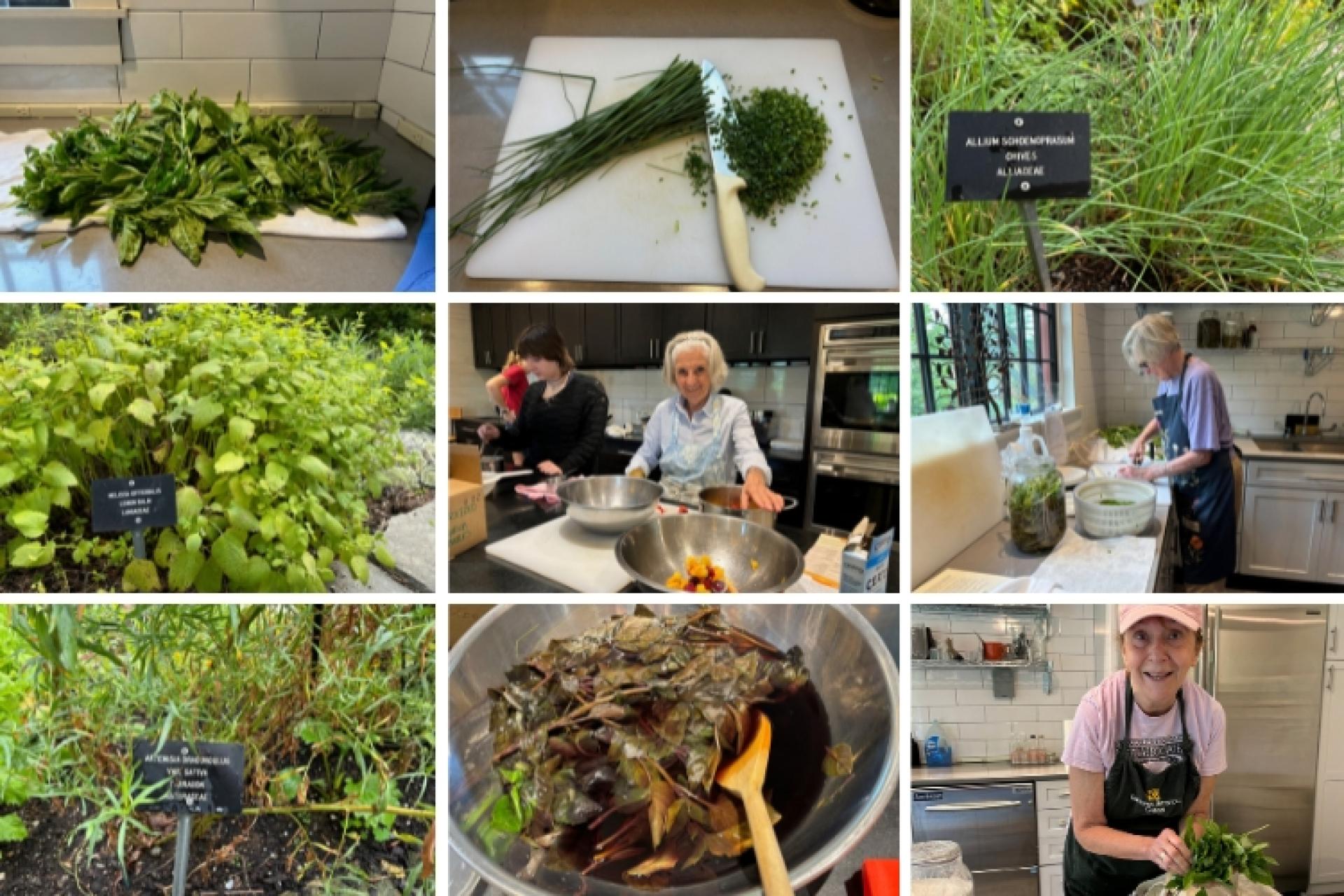You are here
What Is Happening This Week (July 30) at the BBG Herb Gardens and Kitchen (and Yours)?
What Is Happening This Week (July 30) at the BBG Herb Gardens and Kitchen (and Yours)?
By Barbara F. Smith
While this column usually focuses on one or two particular herbs in the BBG Herb Gardens, today we switch the emphasis a bit. We’d like to inspire our readers who are herb gardeners and/or home cooks to try something different. “July is the month of herbal vinegars,” commented Elizabeth Leonard, BBG Herb Display Garden coordinator for the Herb Associates. “Harvesting is in high gear, and the BBG Herb Gardens have tarragon, chives, and lemon balm readily available for the Herb Associates to use.” (See, photos above.)
Certainly, many herb gardeners and home cooks have favorite recipes featuring herbs. But perhaps a less conventional use is to prepare a herb vinegar using apple cider vinegar as the base and fresh herbs from your garden, farmers’ market, or grocery store. “While making your own herbal vinegars may not change your life, it can transform your culinary habits, as they can be used in virtually every aspect of cooking” (Herbal Vinegar by Maggie Oster).
A good herb combination currently available combines fresh tarragon (Artemisia dracunculus, var. sativa), chives (Allium schoenoprasum), and lemon balm (Melissa officinalis) along with shallots and garlic cloves. Place your (washed and dried) herbs in a glass jar with the shallots and garlic. Pour apple cider vinegar over the herbs, making sure that they are entirely covered by the vinegar. (If the herbs are exposed to the air, you may introduce bacteria into the vinegar.) Some recipes suggest two parts vinegar for one part herbs. For this non-recipe recipe, you can use various combinations of herbs, and the amount of each can vary — it’s a matter of personal taste.
Seal the herbal vinegar jar using a plastic, glass or rubber lid. If one is not available, cover the jar opening with plastic wrap or parchment paper and then screw on the metal lid. (The plan is to keep the vinegar separate from the metal, which may corrode and ruin the vinegar.) Label and date the jar. Store the vinegar in a cool, dark place (or at least out of sunlight) for a minimum of two weeks or up to 6 weeks, for a stronger flavor. Once the vinegar has reached the strength you prefer, strain out the herbs and pour the vinegar into bottles for longer-term storage, with appropriate labels and dates.
Once you’ve experimented with vinegar making using apple cider vinegar as the base, you may branch out and use all sorts of vinegars as your base — balsamic, champagne, malt, red wine, white wine, or rice wine vinegar — along with various herbs to achieve different flavors. With a little effort and patience, you will produce delicious vinegar that you can enjoy for months to come. The herbal vinegar described would work well in a bean salad or in a barbecue sauce, for example. Herbal vinegars can be used in salad dressings, vinaigrettes, marinades or even as the basis for shrubs, the popular drink additive made with fruit, botanicals, sugar and vinegar. Your own homemade herbal vinegar would make a lovely gift for friends or family members; consider including a recipe for use along with the gift.
We hope this inspires you to try your hand at preparing a herbal vinegar; let us know how it goes! For more ideas and recipes for homemade flavored vinegars we suggest you check out two books — “Herbal Vinegar” by Maggie Oster and “Flavored Vinegars” by Michael Chiarello.
Our Herb Associates Kitchen Crew prepared a wide variety of products today. The Production Garden’s basil looked beautiful and smelled heavenly. It served as the basis for “Tomato Basil Dressing.” Likewise, the strikingly beautiful opal basil was used to infuse vinegar and to make a batch of opal basil jelly. “Lemon Basil Simple Syrup” and “Peppermint Simple Syrup” were prepared. Simple syrups make a delightful addition to your favorite cocktail or mocktail. More plums from the Tree of 40 Fruits (described in last week’s column) provided the basis for a batch of “Plum Jam.”
As for products made with dried herbs, Herb Associates were busy stripping lavender flowers from their stems to be used in a batch of “Herbes de Provence,” and the popular recipe for “Herb Salt” featuring a combination of dried marjoram, thyme, lovage leaves and various powdered herbs was assembled. Still other Herbies were busy labeling and tallying all the products made. You can find them in the Visitors’ Center Gift Shop on your next trip to the Botanical Garden.
Thank you for your ongoing interest in all things herbal at the Berkshire Botanical Garden!
The Berkshire Botanical Garden’s Herb Associates began in 1957 and have been making and selling products for the benefit of BBG ever since. At BBG, the Herb Associates oversee a display garden and production garden, both located near the Center House. Members/volunteers meet every Tuesday morning during the late spring through mid-autumn each year, coinciding when the gardens themselves are open to the public. Members plant, weed and tend the gardens, as well as harvest and process the variety of herbs.
Help Our Garden Grow!
Your donation helps us to educate and inspire visitors of all ages on the art and science of gardening and the preservation of our environment.
All Donations are 100 percent tax deductible.


